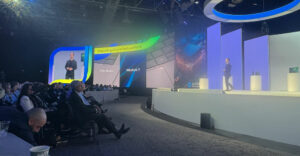
IBM claimed bragging rights Wednesday as its Roadrunner supercomputer earned the title of the world’s most powerful supercomputer. The ranking, bestowed during the International Supercomputing Conference in Dresden, Germany, is a biannual event that ranks the 500 most powerful computers around the world.
The Roadrunner, located at the U.S. Department of Energy’s Los Alamos National Laboratory, achieved a peak performance of 1.026 petaFLOPS (floating point operations per second) to take the top spot. It was the first time a supercomputer has been documented performing more than one quadrillion FLOPS.
The computational performance feat knocked perennial winner IBM’s Blue Gene/L System, another Department of Energy system located at the Lawrence Livermore National Laboratory, out of the top spot it had occupied since November 2004.
“TOP500 ranking[s] bring bragging rights mostly. Because of the way the list is compiled, it’s often more about quantity of hardware than anything else,” said Gordon Haff, a senior analyst at Illuminata.
What is significant, however, is that the Roadrunner outperformed other supercomputers using a hybrid processor design that combines its Cell Broadband Engine with AMD’s Opteron dual-core processors.
From Teraflops to Petaflops in 12 Months Flat
Six months ago, Blue Gene/L reigned supreme among the world’s fastest computers with a record 478.2 teraFLOPS. One year ago, Blue Gene/L clocked in at 280.6 teraFLOPS.
Trillions of calculations each second was only good enough for second place this time around, however. Blue Gene/L fell to No. 2 repeating its performance from the fall 2007 list of 478.2 teraFLOPS.
“The TOP500 leaders have been growing faster than Moore’s Law. The reason is that these computers are growing larger (more cluster nodes) as well as faster in the individual nodes,” Haff explained.
Completing the top five positions was IBM’s new Blue Gene/P, located at the Department of Energy’s Argonne National Laboratory, in the No. 3 slot with 450.3 teraFLOPS. Sun’s new SunBlade x6420 Ranger system at the Texas Advanced Computer Center at the University of Texas came in fourth with 326 teraFLOPS. In the No. 5 spot was the Department of Energy’s Oak Ridge National Laboratory system, the upgraded Cray XT4 “Jaguar” with 205 teraFLOPS.
IBM ruled the Top500 list, with 210 of its systems making the cut. However, that was a decrease from six months ago, when the company had 232 systems on the list. HP was second with 183 systems but saw its share increase over six month ago, when only 166 of its systems on the list.
Everyday Processors, Extraordinary Results
Perhaps surprisingly, more than 5 million PlayStation 3 owners in the U.S. have first-hand knowledge of at least one of the processors that carried the Roadrunner to victory. The IBM supercomputer is powered by 12,240 IBM PowerXCell 8i Cell chips similar to those found in the gaming console. The system’s 6,562 AMD Opteron dual-core processors handle the basic compute functions, leaving the Cell chips available to deal with the heavy lifting necessary for the math-intensive calculations in which the processors specialize.
The Cell processor is a multi-core chip that’s part of the larger trend toward higher multi-core integration. IBM’s inclusion of these moonlighting video game chips is an endorsement of the processors for use in high-performance computing.
“In this case, the fact that this system is a ‘hybrid’ architecture combining Opteron and the Cell processor highlights an interesting trend that we’re going to see more of. It also highlights that this is a big software problem to be solved, given that current tools don’t support developing for this type of architecture at all well,” Haff told TechNewsWorld.
However, it is unlikely that the hybrid technology found in Roadrunner will eventually trickle down to the consumer market in some way in the foreseeable future, said Michael Corrado, an IBM spokesperson.
“It’s possible but unlikely that a consumer device would require the degree of computational power provided by hybrid designs. Consumer devices will always need longer battery life, more bandwidth and more memory, but very few would require extra computational power. In fact, it’s interesting to note how supercomputer designers today are borrowing technology from consumer electronics — video game chips,” he told TechNewsWorld.




















































